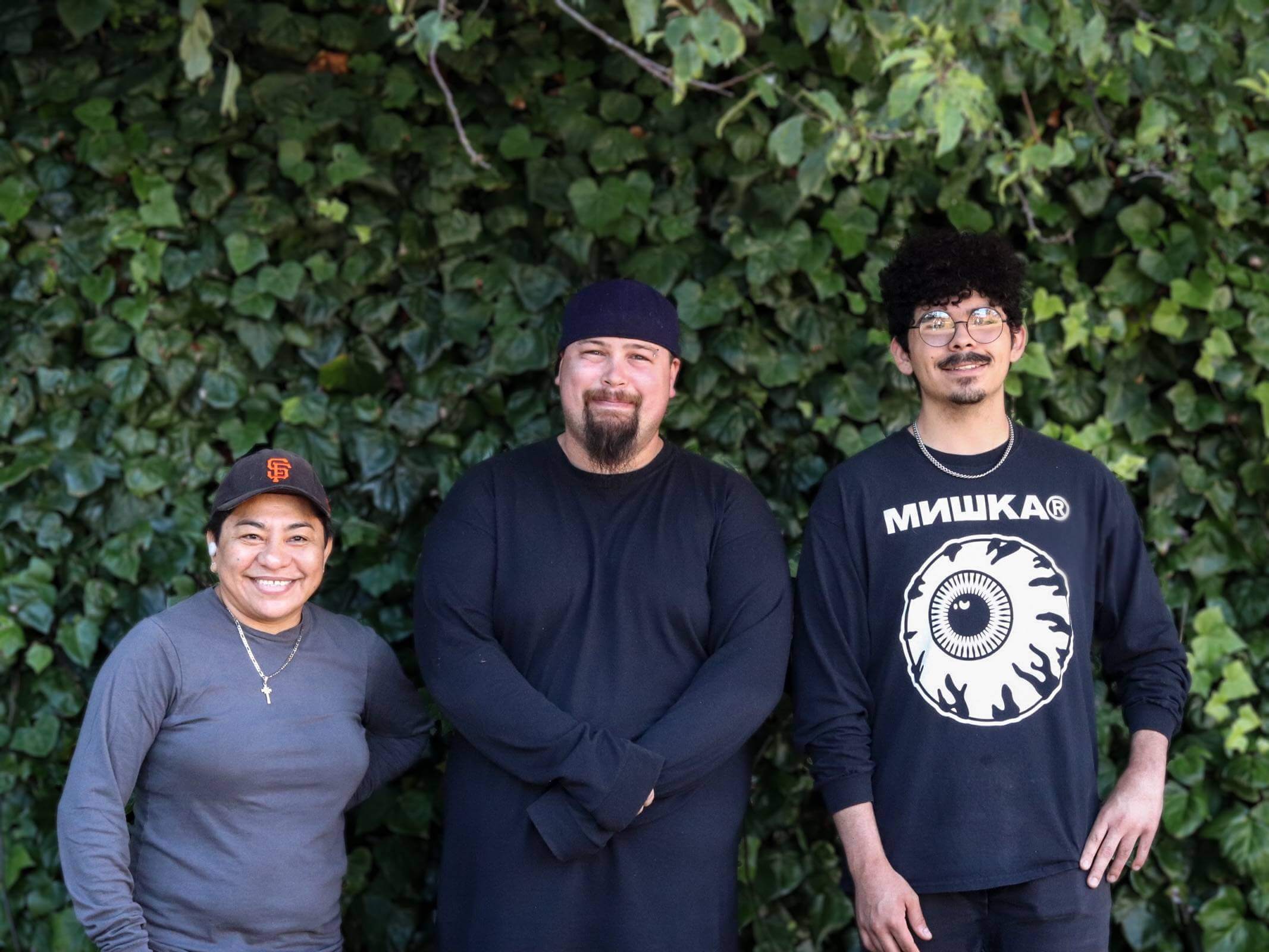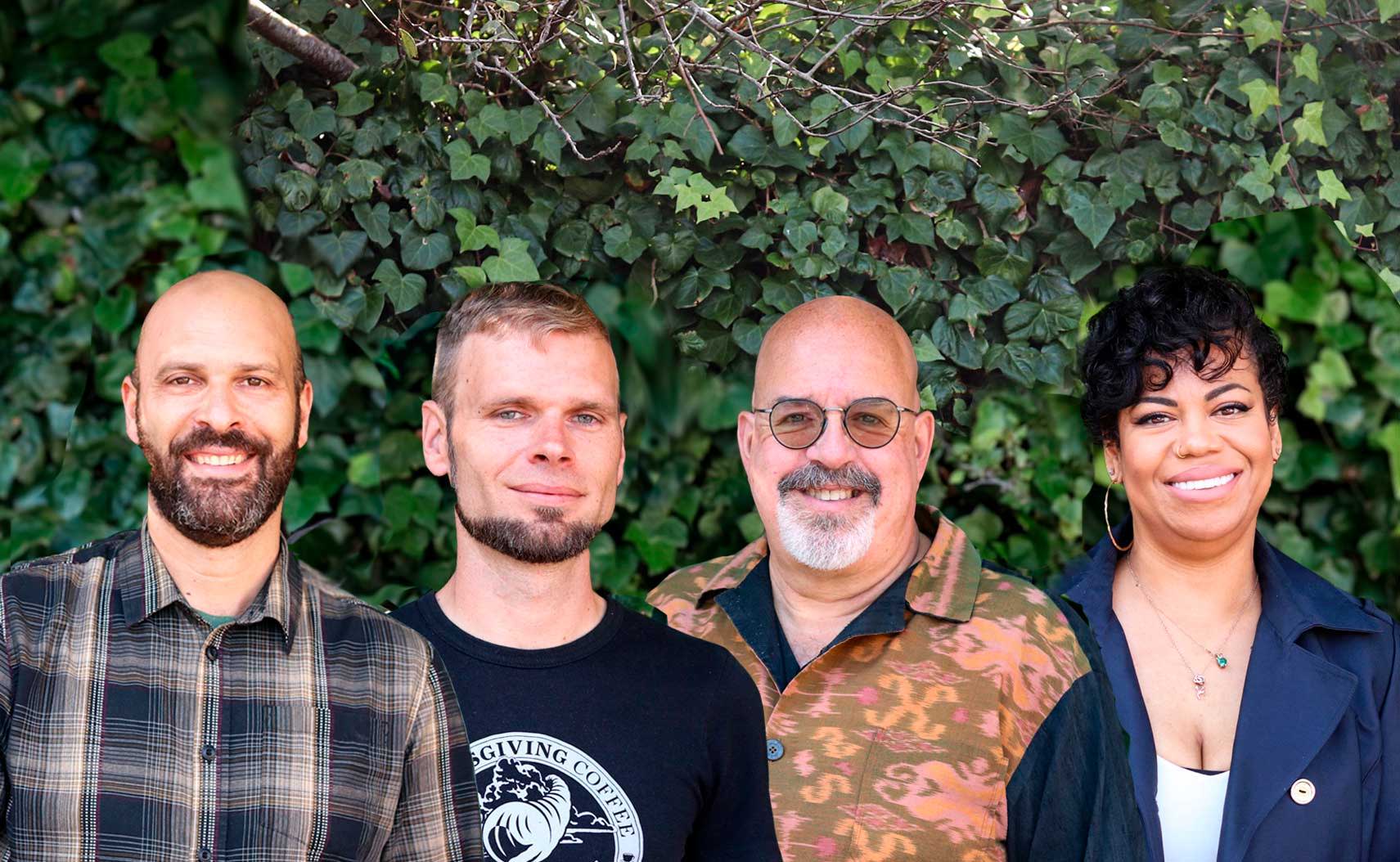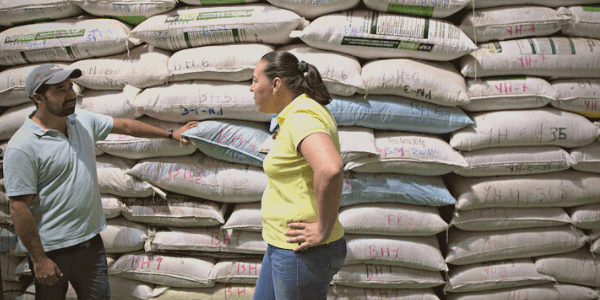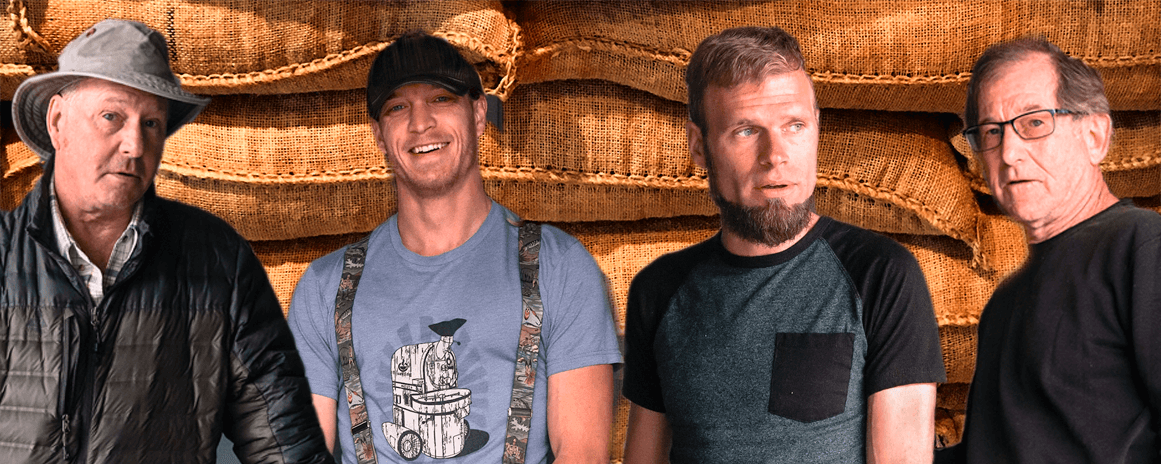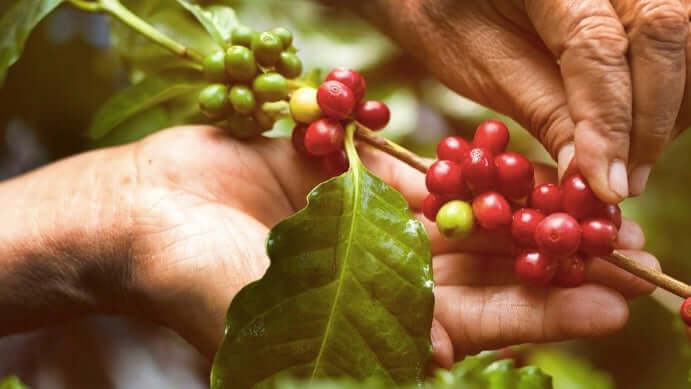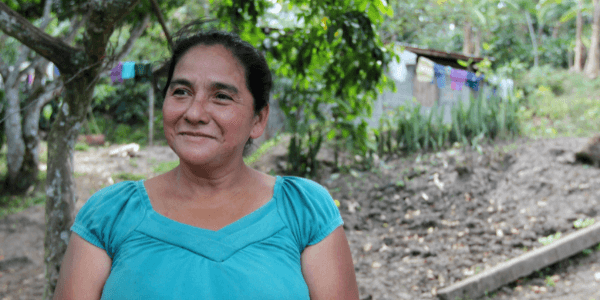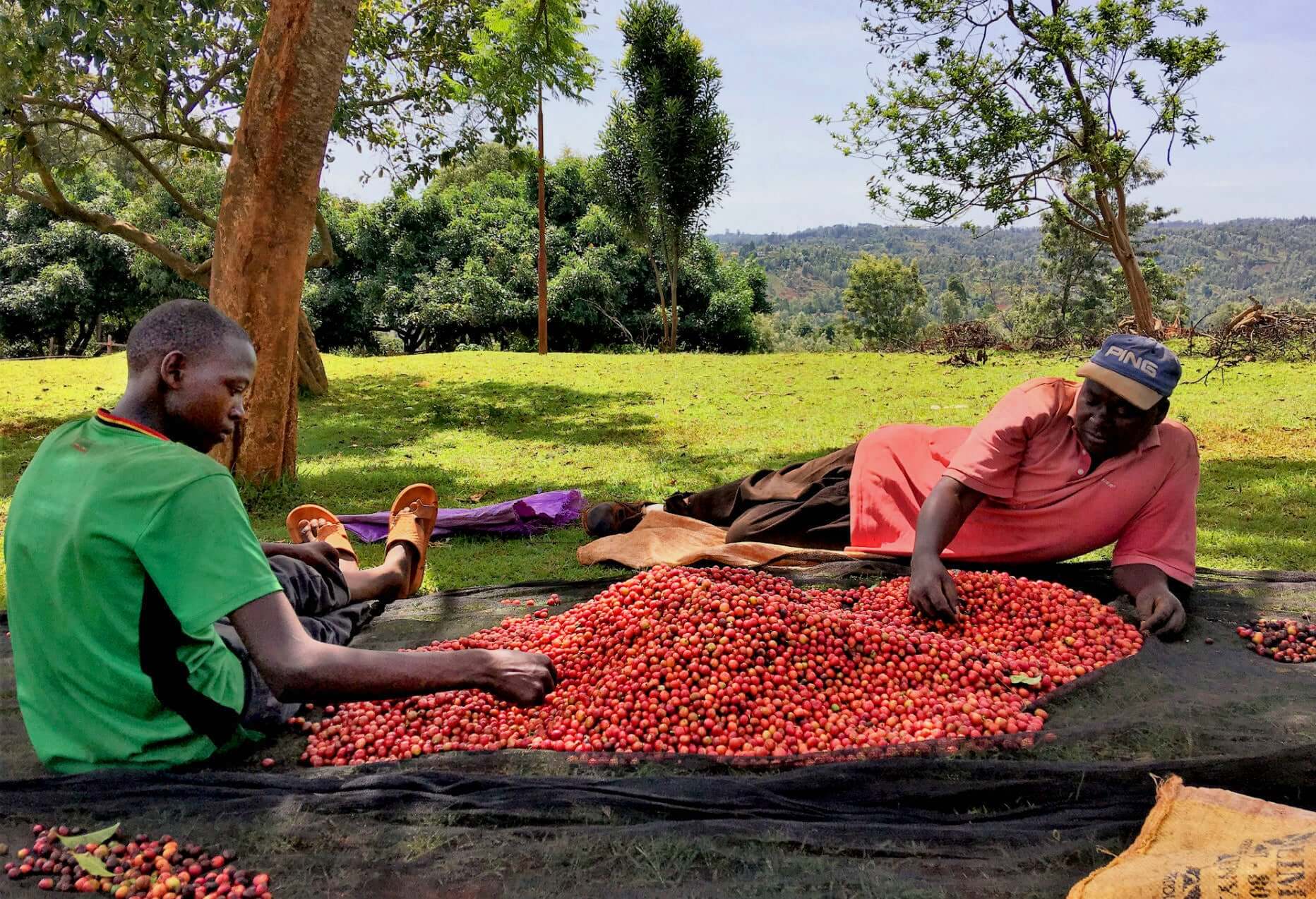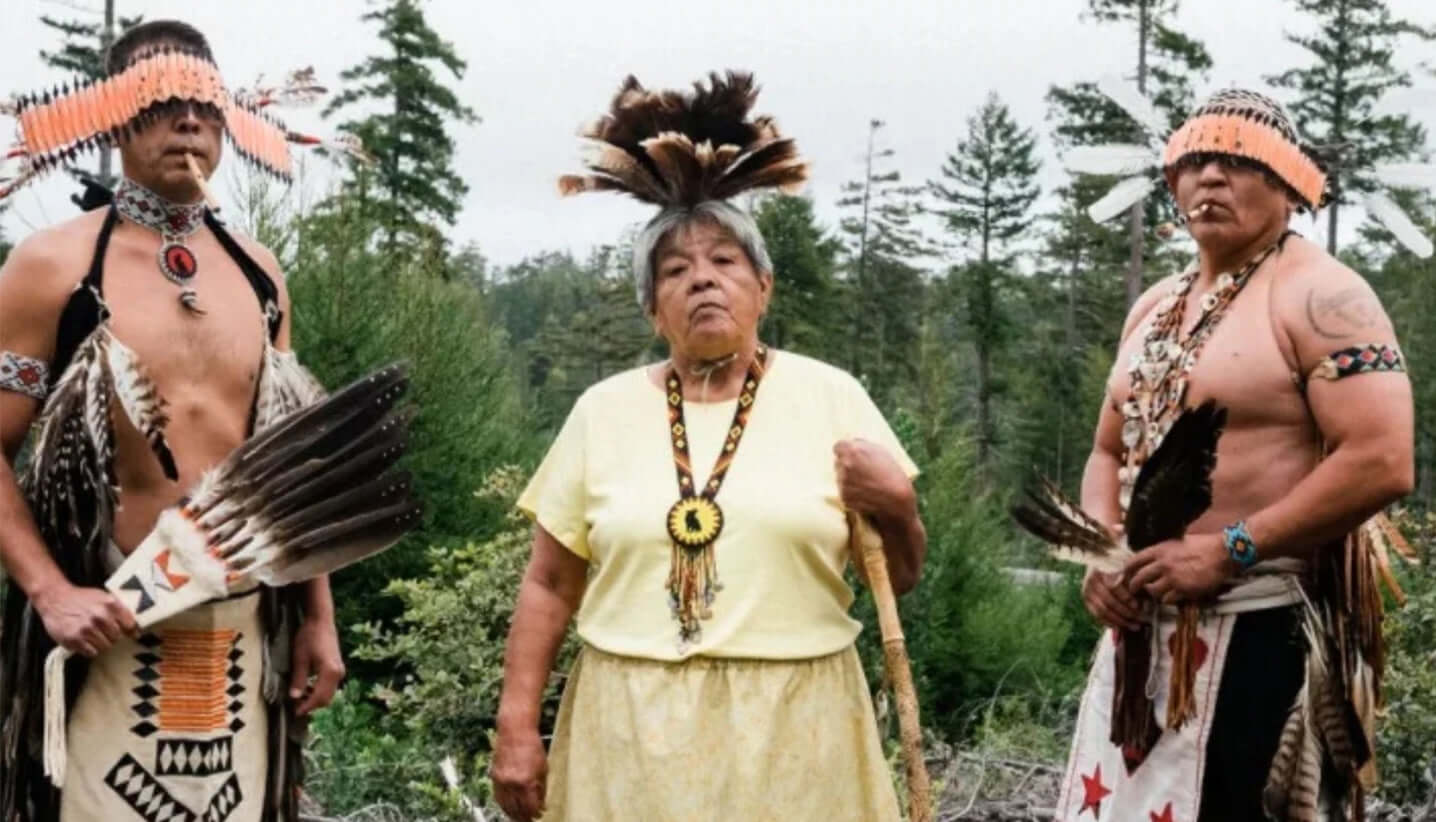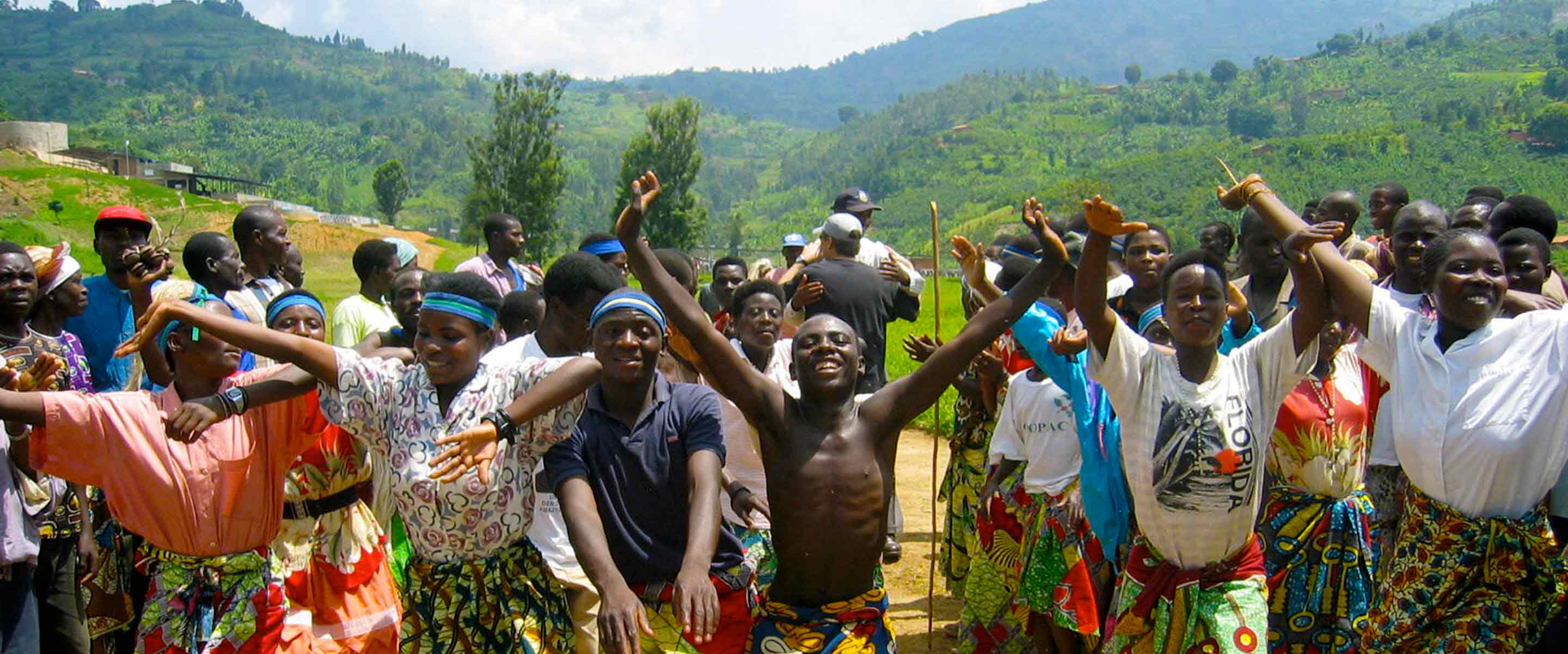
News, Stories and more
Our Blog
View BY :

Earning Beans For Coffee Rewards
Thanksgiving Coffee Company Appreciates You We have made it simple and effective for you to get the appreciation we think you deserve. It is the “Earn Beans” reward system. Yay! These rewards will be counted as “beans” which you can redeem as discounts. The more beans you earn the greater the discount, all the way up to free products!
read more-
![Roastmaster's Select Club: Pichincha Imbabura Chirimoya]()
Roastmaster's Select Club: Pichincha Imbabura Chirimoya from Ecuador
Once a month, members of the Roastmaster’s Select Coffee Club have the opportunity to sample unique micro-lot coffees from around the world. “What is a micro lot,” you ask? Read up on how we source the beans and what happens when they reach our roastery.
Following the harvest cycle, Roastmaster’s Club Members have exclusive access to these one-of-a-kind coffees at their peak freshness, and now it’s your turn!
This month we're sharing coffee grown in Ecuador by Farm Crus Loma de Galo Morales and roasted here at Thanksgiving Coffee in Fort Bragg, CA.
The Story Behind the Coffee Bag
Introducing this month's Roastmaster's Select coffee, picked by Roastmaster, Jacob Long, Pichincha Imbabura Chirimoya. The Cruz Loma Farm is sheltered by the subtropical climate of San José de Minas to the northwest of the province of Pichincha at a height of 1,450 meters above sea level. These conditions make it possible to obtain a variety of quality products from its land, such as soursop, corn, beans, naranjilla, orange, tangerine, and, of course, the best coffee. One of the most important motivations of coffee farmers, Galo Morales, is to positively collaborate with the community's economic development, through implementing productive practices that benefit the local population around the farm. In addition, this activity allows him to connect with his family since his wife and daughters actively collaborate in its production and marketing. Being involved in the world of coffee has allowed him to value the effort, love, and passion that a producer must dedicate to his activity in order to achieve the highest quality; also, it has allowed him to improve his relationships with people by sharing the knowledge and experience that you have acquired over the years.
Altitude: 1,500-1,800 meters
Processing: Fully washed and dried in the sun on raised beds
Farmer: Finca Cruz Loma
Varietal: Caturra, Typica
Roastmaster's Select Club: Pichincha Imbabura Chirimoya
read more -
![Thanksgiving Coffee Turns 50]()
50 Years of Business
1972-2022
Thanksgiving Coffee Company turns 50 this year. We created a video to celebrate the highlights and history of our company, which was established using our business as a force for good, with coffee as our medium. The video below offers a glimpse into the social and environmental justice built into the heart our the company and how we are working to bring health and well-being to our farmers.
"THE WAY"
The way to great coffee flavor is not direct. The path must be traveled with great care and attention. The way becomes a path, the path a road, and then, magically, the road becomes a highway that leads to people who cultivate the land from which the coffee derives its special flavor. How does one find the path? Through caring. One does not search so much for the road that leads to the tree, as for the road that leads to the heart. This is the secret.
-PAUL KATZEFF, CO-FOUNDER
Now the new generation is here to steward the regenerative business forward. Jonah Katzeff is the new CEO, while his parents Joan and Paul remain active members of the Board to guide their son for many years to come.
Our motto, and it is true as ever... Not Just A Cup, But A Just Cup.
Thanksgiving Coffee Company
50th Anniversary
1972-2022
Thanksgiving Coffee Turns 50
read more -
![50 years... One Bean at a Time]()
Thanksgiving Coffee Company Celebrates 50 Years
Thanksgiving Coffee Company turns 50 this year and we would like to celebrate our co-Founders, Joan and Paul Katzeff. They set the example for us to use our business as a force for good, with coffee as our medium. They instilled social and environmental justice as our passion and the health and well-being of our farmers as our goal.
Joan and Paul have led the specialty coffee industry toward equality and justice. For five decades they have spearheaded ethical sourcing directly from small-scale farmer cooperatives, building the first independent farmer-owned cupping labs and inspiring the first Fair Trade model.
Working shoulder to shoulder with the farmers, Thanksgiving Coffee has developed one of the most valuable supply chains in coffee today. At the core, our company is built on the interconnectedness of coffee farmers, the coffee they produce, and the health and well-being of our shared environment.
“A coffee farmer will love their trees when they provide food, shelter, education, and health care for their family. When a farmer loves their trees, they will care for them in a way that produces fine quality and flavor. Great coffee derives from the welfare of the farmer and their family. It is true for all farmers who work the land, including our local farmers.”
– Paul Katzeff, Co-Founder
Now Thanksgiving Coffee is being led by Joan and Paul's son, Jonah Katzeff, who has literally been part of this company his entire life. With a solid foundation to build upon, we now look to the next 50 years with a sense of excitement and purpose. Our motto, and it is true as ever... Not Just A Cup, But A Just Cup.
Thank you, Joan and Paul!
Thanksgiving Coffee Company
50th Anniversary
1972-2022
50 years... One Bean at a Time
read more -
![Production Crew of Thanksgiving Coffee Company]()
Our team that gets the coffee to you
The arms and legs of the company are found in our Production Team as they move smoothly between the freshly roasted beans, to the final customer packages. This zone is buzzing with movement from the fresh batch of beans rushing down the gravity feed shoot to a new coffee barrel. The Production crew mixes the different roasts and portions carefully to produce the great flavorful blends. When needed, they take the whole beans and grind them to the right specifications to be brewed to their highest potential. The crew then takes all this tasty roasted coffee, box it up, and ship it out to you, our customers. Here they are.
Palmer Evans – Production Supervisor
Palmer Evans has been with Thanksgiving Coffee Company for seven years. He enjoys the people he works with and likes what the company stands for. When he is not at work he does what his kids want to do… Play video games, spend time with family and their dogs.
Palmer enjoys rock music, but he can listen to just about everything except bag pipes…. “Never could get into those”, he says. His favorite Coffee is Kenya Peaberry, however, he does like mixing Kenya Peaberry and the Ethiopian Gedeb together 50/50. “Its SUPER fruity”. He likes to brew his coffee using a French Press.
Celia Garrido - Shipping
Celia Garrido has worked with the company for over 21 years. This position has been a huge part of her life. She has worked here for so long that she watched her kids grow up and the company grow at the same time. It has been a fun and interesting job in her eyes. She likes to be here because she finds the environment positive, interesting, and she likes making our customers happy.
When Celia is not working, she likes to be home and care for her grandbaby, as nothing else compares to her Christina. She likes to relax, doesn’t really like to cook too much anymore, mostly it is all about her grandchild.
Her favorite music is romance and Cumbia, and her favorite bands are Panco Barraza and Julio Jaramillo.
Celia’s favorite coffee is Byron’s wash from Nicaragua and her second favorite is the FairTrade Beaujolais blend. She brews it in a drip coffee maker at home and likes to add a chocolate creamer or just milk.
(No Photo Requested)
Sonia Sosa - Production
Sonia Sosa has been with the company for two years. She likes the location of the company in town and appreciates the kind people that she works with.
When Sonia is not working, she likes to take walks, to rest, and watch TV. Her favorite music is Mexican Reggaeton. She also likes Karol G - Provenza. Sonia’s favorite coffee is Mocha Java and brews it on a drip coffee maker. She takes her coffee with milk.
Jerret Mitts – Shipping
Jerret recently joined our production crew in shipping and has been a wonderful asset to our team.
Here are the coffees our production crew like, want to try one?
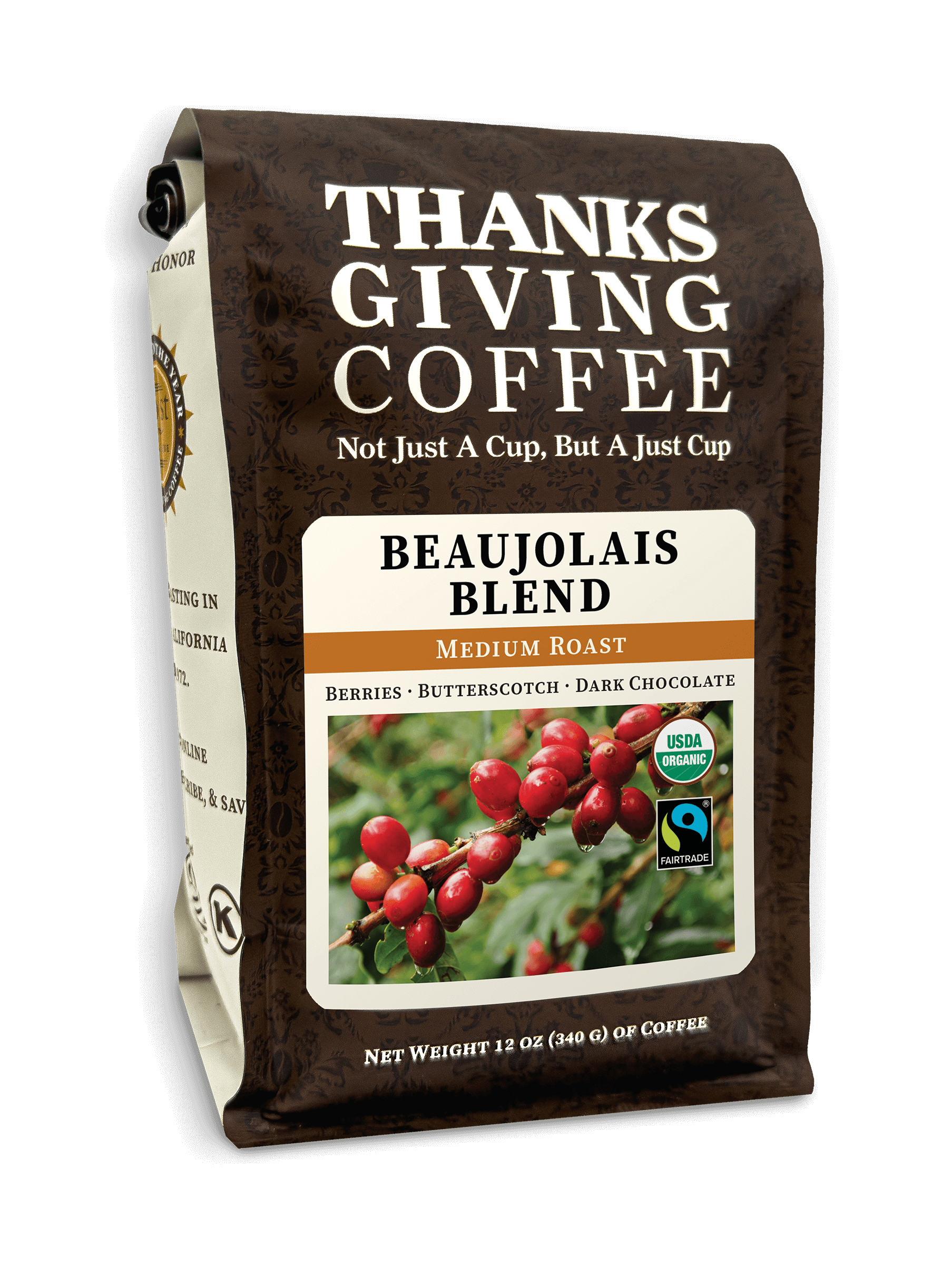
Beaujolais Blend - Medium Roast
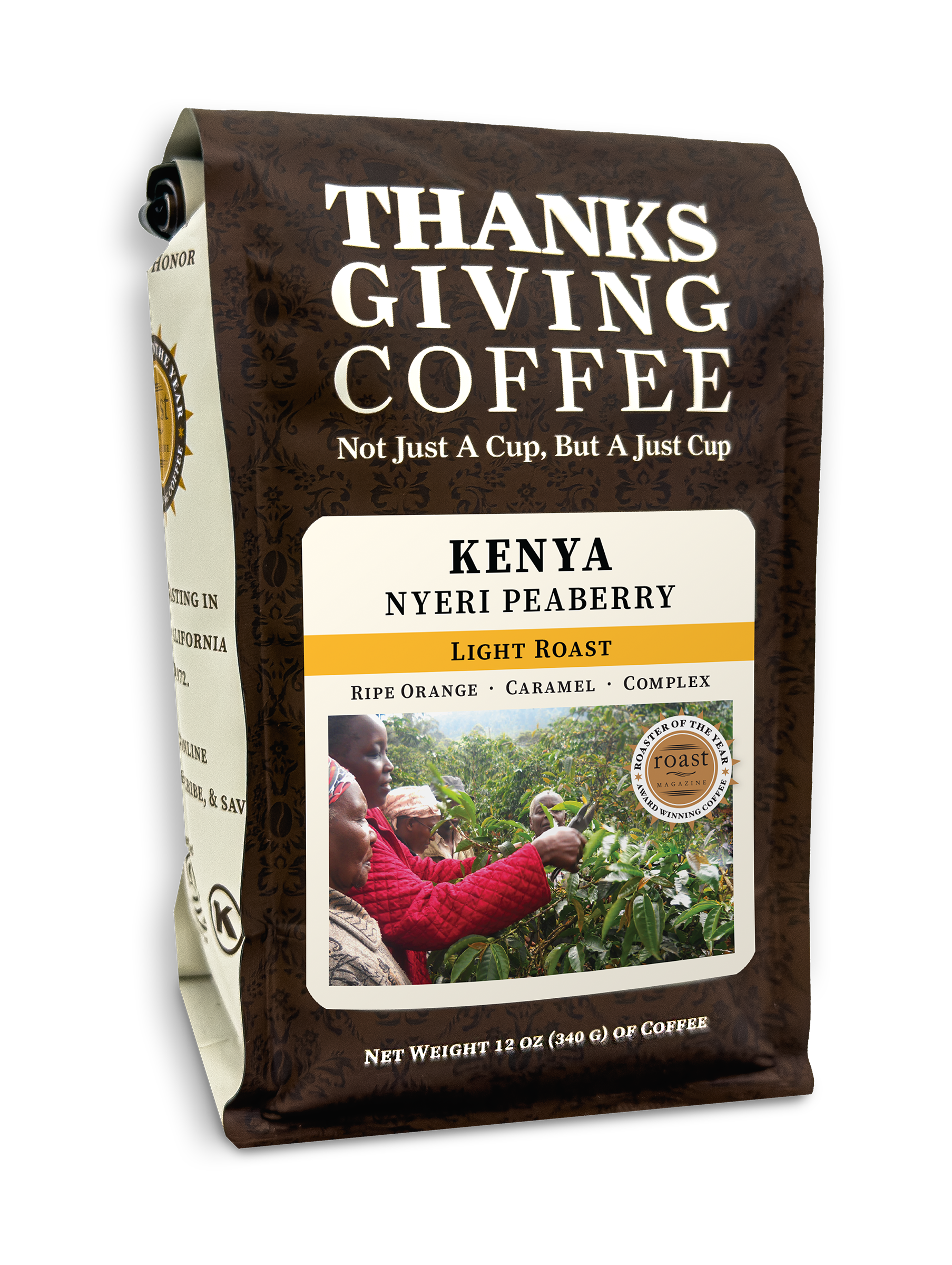
Kenya - Nyeri Peaberry
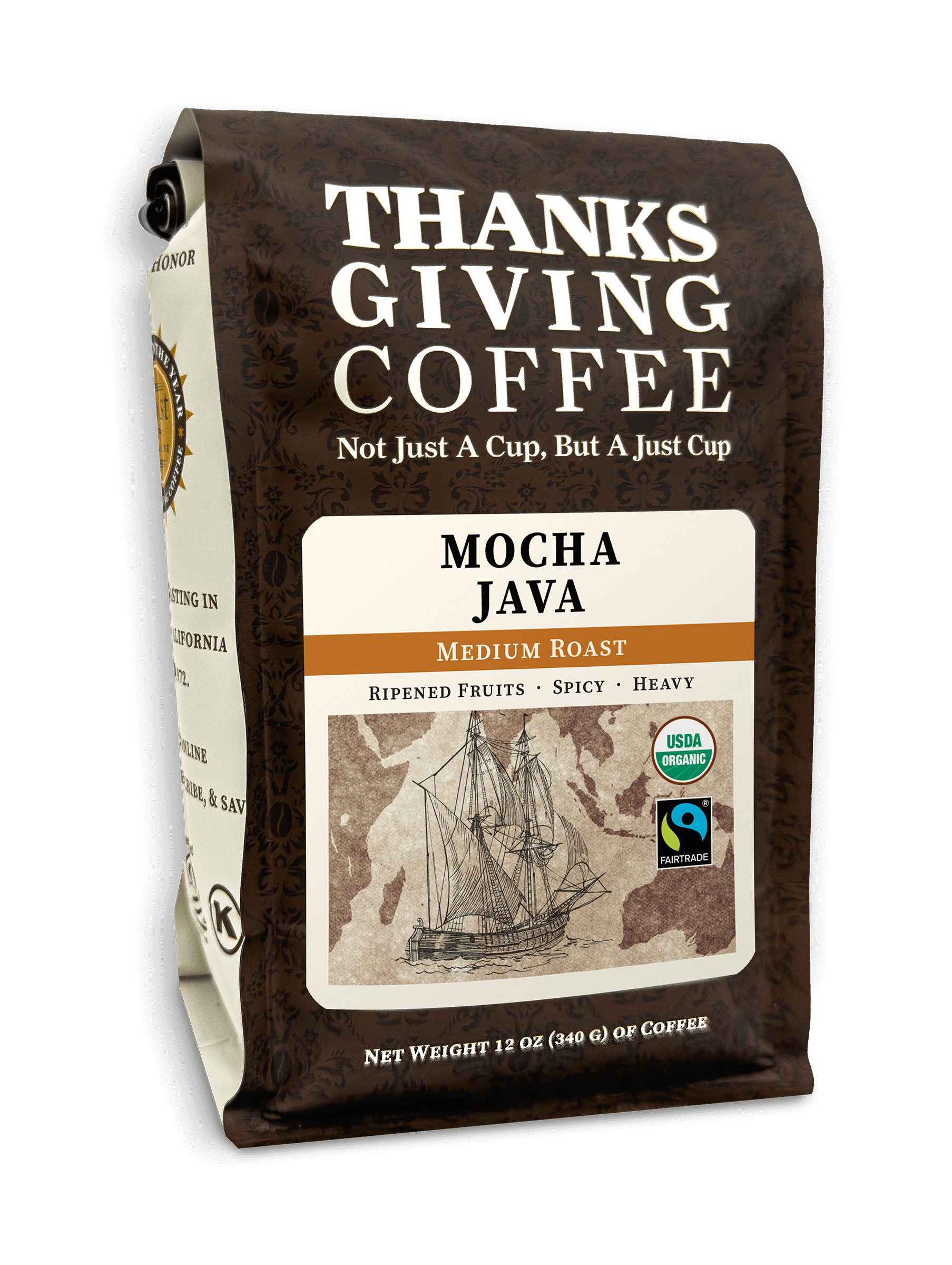
Mocha Java - Medium Roast
Production Crew of Thanksgiving Coffee Company
read more -
![Our Roastmaster's Select, Picked Just for You!]()
Roastmaster's Select Club: COCASAM Coffee from Honduras
Once a month, members of the Roastmaster’s Select Coffee Club have the opportunity to sample unique micro-lot coffees from around the world. “What is a micro lot,” you ask? Read up on how we source the beans and what happens when they reach our roastery.
Following the harvest cycle, Roastmaster’s Club Members have exclusive access to these one-of-a-kind coffees at their peak freshness, and now it’s your turn!
This month we're sharing coffee grown in Honduras by COCASAM Cooperative and roasted here at Thanksgiving Coffee in Fort Bragg, CA.
COCASAM: Coffee from Honduras
Founded in 1988, COCASAM Cooperative resides on Botija ridge, a mountainous area in the Municipality of San Marcos de Colón. This cooperative produces excellent coffee with quality over quantity in mind. In fact, they have a small section of farm land within a sacred pine forest and are not capable of expanding due to its protection as a reserve. This leads them to focus on the quality of the coffee and to improve their technique rather than producing more each year.
With the importance of preserving the planet in mind, COCASAM relies on traditional methods of production that were first introduced in the coffee world in the early 1800s - and, ALL of the coffee is shade-grown and sun-dried. Not only that, but when you receive this coffee, you'll feel accomplished in knowing that you're helping to provide comfortable living conditions for each farmer in this cooperative and their families for generations to come.
Altitude: 1,200-1,600 meters
Processing: Wet/Washed
Farmer: COCASAM Co-op
Varietal: Caturra, Pacamara, Bourbon
Our Roastmaster's Select, Picked Just for You!
read more -
![The Story Behind Canto de Bolivar]()
Single Origin Club: Canto de Bolivar
What is a Single Origin coffee? Simply put, these coffees are defined by the place they come from.
Single Origin coffees are from a specific farm or group of farms that make up small cooperatives. You’ll find that most of our Single Origin coffees are light roasted.
This month we're sharing our Canto de Bolivar coffee grown in Bolivia by the ASOCAFE Cooperative and light-roasted here at Thanksgiving Coffee in Fort Bragg, CA.
About the Farm
The Caranavi province is the heart of coffee production in Bolivia, surrounded by rivers that flow from glaciers 4,000 meters above carve deep valleys and create an ideal landscape for the cultivation of exquisite coffee. The farmers of ASOCAFE grow prized varietals on their small farms and transport their carefully hand-picked coffee to central processing stations, where, under the watchful eye of the cooperative’s staff, the ripe cherries are depulped, fermented, washed, and sun-dried.
Perched atop fertile mountain ridges in the foothills east of the Andes, 300 farming families produce one of Bolivia's sweetest coffees under the shade of lush jungle canopy. These farmers are members of ASOCAFE, a cooperative founded in 1990 in an effort to improve the quality of the area's coffee and, consequently, price and income for farmers, leading to a better quality of life.
Altitude: 1,800 meters
Processing: Wet/washed
Farmer: ASOCAFE Cooperative
Varietal: Typica/Caturra/Catui
Not ready to join the Single Origin Club? Make a one-time purchase of our Canto de Bolivar light roast coffee.
The Story Behind Canto de Bolivar
read more -
![Night Of Native Cinema]()
Reflections of Mendocino Film Festival 2022
The Mendocino Film Festival (MFF) began in 2006, and Thanksgiving Coffee Company has been a steady supporter since the beginning. This 2022 season an innovative program called "Native Cinema: Vision the Future" was lanched. This was created and produced by the Bee Bold Alliance (a project from Thanksgiving Coffee) to help tell the story of Mendocino’s regenerative renaissance.
The overwhelming positive response of the Native Cinema program demonstrated an earnest interest in the Native experience. It was screened to a sold out audience at Crown Hall in Mendocino, CA. and featured many wonderful Native Filmmakers and several remarkable local Native Leaders.
The tone of the evening was set by local coastal Pomo activist and cultural revitalizer Bernadette Smith. With her moving ancestral songs for the land, Smith gave respect and honor to her heritage and for those in the audience, the cultural experince of the original peoples of Mendocino, CA. Priscilla Hunter from the Coyote Valley Band of Pomo joined Smith in this acknowledgment with her prayers and helped amplify the intention for the evening of Native Films to come. (image: Bernadette Smith on left, Priscilla Hunter on right)
Strengthen our connection through Indigenous Storytelling
Part I
The Cinema portion began with the film Chasing Voices (a “Pat’s Pick”) documentary about Ethnographer John Peabody Harrington who spent 50 years recording and documenting over 150 different, dying Native American languages. This film has been included in Rhode Island International FF, Montana Int FF, Mother Tongues FF, and the Smithsonian Institution in Feb 2022. (image: Pat Ferrero left, Daniel Golding right)
Director/Producer Daniel Golding is an award-winning Native filmmaker with a degree in Cinema and American Indian Studies from SF State University. He has been making award-winning documentaries for the past twenty years and teaches digital filmmaking workshops to at-risk tribal youth through his Hokan Media Digital Filmmaking Academy.
After viewing this unique and intriguing film, the audience engaged in a Q&A led by Pat Ferrero with director Daniel Golding. Listen to more behind the making of Chasing Voices at Forthright Radio here.
Part II
Nathaniel Golding hopes audiences will take away how a positive outlet will lead to positive things.
Part II of the Native Cinema program featured AWAKEN, a short film about the issues young people face on the Fort Yuma Reservation in Southern California. The first-time filmmaker Nathaniel Golding (an enrolled member of the Quechan tribe) tells the story of cousins Orlando and Kieran whose love for metal music has not deterred them from learning their traditional songs and dances. Nathaniel was the youngest film crew member. He is learning the Quechan language and songs and was inspired to make this film by his father, producer Daniel Golding.
(Image: Awaken filmmaker Nathaniel Golding)
The second film Forest Grandmothers explores the activism of Priscilla Hunter (Coyote Valley Band of Pomo Indians) and Polly Girvin (Indigenous Rights Lawyer). For the past 40 years, they have tirelessly worked to preserve the forests and educate others about the cultural significance of biodiversity for Native People and the wellbeing of the planet.
(Image: Forest Grandmothers filmmaker Henry Thomas, center)
This unique film project was directed by first-time filmmaker Henry Thomas who led the Bee RYL Production Crew, a multicultural and multi-generational mentorship for youth to sustain local art and culture through film. Henry Thomas is a young aspiring filmmaker combining digital video with analog photography.
The Bee RYL Crew for 2021-22: Ronan Williams, Keiran Miller, Kyla Marchello, Josephine Steinbeck, and camera support from Amy Heckeroth.
*Bee RYL Productions is a pilot project of the Bee Bold Alliance led by Lavender Grace Cinnamon and sponsored by Thanksgiving Coffee Company in partnership with Hope4Natives, Mendocino Film Festival, and MHS Media Lab.
Bernadette Smith opened the third film Chishkale: Blessing of the Acorn, with a beautiful spoken word in her native Kashia language in honor of the Acorn. This dance film with Bernadette was created to honor Tan Oak conservation efforts and the sacred, traditional food of California Natives. Bernadette dedicates her life to the restoration and revitalization of the Chichkale, (the Kashia word for the Tan Oak) with the use of contemporary dance and music she breathes new life into her beautiful Pomo language and culture. (Image:Bernadette Smith, Coastal Pomo)
Chishkale filmmaker Linda Mai Green likes to tell stories of previously overlooked people. Green's films are for audiences who, like her, hunger to see an inclusive, multicultural world where they are reflected in all their complexity and nuance. Drawing on her biracial Vietnamese identity and her background in art history and literature, she is currently developing films that focus on the immigrant cultures and turbulent history of her home state of California.
(Image:Chishkale filmmaker Linda Mai Green)
The fourth and final film of the evening was Pomo Land Back: A Prayer from the Forest by filmmakers Evan-Marie Petit & Louis Fox. Hailing from the red earth of her ancestors, visual storyteller Petite is from the Eastern Cherokee.
This film aims to honor the vital movement towards indigenous-led stewardship and rematriation of California forest lands. Created in collaboration with the Coyote Valley Band of Pomo Indians, Pomo Land Back is a visceral poetic document of an alliance-building, inter-tribal gathering that took place in February 2022. The Coyote Valley Band of Pomo Indians calls for protection and co-management of the 48,652-acre Jackson Demonstration State Forest.
(Image:Pomo Land Back filmmaker Evan-Marie Petite)
A Q&A panel comprised of all the Filmmakers was hosted by Hawaiian Kanaka U'ilani Wesley along with local artist and Sustainable Ecology Advocate, Lavender Grace Cinnamon.
(Image: Lower level left to right Bernadette Smith, Linda Mai Green, Lavender Grace Cinnamon, U'ilani Wesley. Top left to right Henry Thomas, Evan-Marie Petite, Nathaniel Golding, Daniel Golding)
The evening closed with two honored local Tribal Leaders Chairmen Michael Hunter and Tribal Chairwoman Priscilla Hunter. Together they addressed the audience with a unique depth and humor all their own. They shared their vision to preserve the local forests and create a clean safe environment for future generations to come. Dynamic in vision and in action, the inspiring Chairman and Chairwoman Hunter actively work for the well-being of the planet and fortunate Mendocino is their home.
Thanksgiving Coffee Company is a proud sponsor of the Native Cinema event. It felt like a step in the right direction to strengthen our communities resilience. The evening created an opportunity to learn and gather some tools to use during these turbulent times. With positive outlets, we can be community-minded and learn how to grow through our shared experiences. Ultimately we are all in this together, let's tell a good story.
(Image: Tribal Chairman Michael Hunter left, Tribal Chairwoman Priscilla Hunter right)
This event was a collaboration with The Bee Bold Alliance, in partnership with Hope4natives and The Mendocino Film Festival and made possible by the sponsorship of Thanksgiving Coffee Company.
Resources:
Sinkyone Intertribal Wilderness Council
*Bee RYL Productions Pilot Project appreciates the generous donations from Sweetwater Inn and Spa, Fortunate Farms, Cafe Beaujolais, Corners of the Mouth, Princess Seafood, and Simone’s Kitchen
Get Involved
If you are interested in learning how to get involved, please reach out. We are most resilient when we honor our diversity and create creative solutions together.
Our Bee Bold Coffee supports biodiversity and Earth renewal with your daily cup of coffee. The Bee Bold Campaign offers a steady funding source for Conservation Works, training youth to support native bees and pollinators with the restoration and preservation of habitats to sustain a resilient ecosystem.
Follow Thanksgiving Coffee Companies Growing Stories.
We use coffee as our medium to do good in the world.
Night Of Native Cinema
read more -
![How to Make Perfect Steamed Milk]()
How to Make Velvety, Naturally-Sweet Milk
Milk becomes naturally-sweet when heated to the ideal, not-too-hot, temperature. (Ever get warm milk before bed as a child... or even as an adult?). It quickly becomes scalded-tasting at too high a temperature. For this reason, it is imperative that the milk steamed for espresso drinks not be over-heated.
Excellent steamed milk vs. sloppy
Step 1: Use cold milk
For best results, use very cold milk and a very cold pitcher. Some baristas leave the pitchers in the refrigerator.
Step 2: Use the proper amount of milk
Pour only as much milk as you will need for a single drink into the pitcher (slightly more than 1/2 of the volume of the cup used). You should be selecting your pitcher based upon the drink you plan to make - a 12 oz pitcher filled to a bit below the base of the pour spout for a cappuccino and a 20 oz pitcher filled to that spot for a latte.
Step 3: Position the pitcher
Position the pitcher parallel to the steam wand and put the wand into the milk so that the end of the wand is just submerged. Hold the pitcher with your non-dominant hand, with the weight of the pitcher held in your hand and with one finger touching the bottom and use the other to operate the steam knob and to gauge the temperature of the milk.
Step 4: Steaming, part one
Turn steam knob so that the steam is on full blast and stretch the milk for only a few seconds, allowing bubbles to form on the surface. Do this for a bit longer if making a cappuccino, for more foam. You should finish stretching the milk before it becomes warm to the touch, to ensure the smoothest, most fine foam.
Step 5: Steaming, part two
Turn the pitcher so that it is parallel to the floor, roughly perpendicular now to the steam wand, as you allow the steam wand to bury further into the milk (about one inch). The milk should begin circulating around smoothly in the pitcher, swirling from top to bottom like a convection current. Do this until the milk is just hot enough that you want to remove your hand from the side of the pitcher, then turn off the steamer and set milk on counter (remember to wipe the steam wand with a damp rag).
Step 6: Polish the milk
Polish the milk by swirling it a few times to make sure all foam is integrated and smooth. It will actually become shiny on top with this action. Tap the pitcher on the counter if any large bubbles remain. The milk should be shiny and smooth, with no visible bubbles, only tiny, frothy ones. It should taste creamy and be warm on the tongue, but not scalding – the right temperature to consume immediately at peak sweetness.
Step 7: Rinse pitcher
Rinse pitcher thoroughly and return it to a cool place.
Integrating your milk with your espresso:
- Pour your desired amount of milk into the pitcher, and leave on the counter while you...
- ...follow Steps to Pull an Excellent Espresso
- As soon as you have pressed the button to start your espresso shot, begin steaming the milk. Milk should take about 20 seconds, espresso about 23-30.
- Follow all steps to velvety, naturally-sweet milk.
- As soon as your espresso is done, begin pouring milk into it. This should be done by tipping the cup so that the milk can pour slowly down the side, again making a convection-like current in the cup. When you have about 1” of room left, bring the pitcher tip close to the drink surface (which may require tilting the cup) while continuing to pour and tip the pitcher at a steep angle toward it, jiggling your wrist so that the foam piles onto the drink. No scooping with a spoon should be necessary.
Shop our best-selling espresso roasts!
Like us on Facebook and follow along on Instagram and Twitter for frequent updates, promotions, giveaways and more!
How to Make Perfect Steamed Milk
read more -
![Roastmaster's Select Club: Timor-Leste]()
Roastmaster's Select Club: Timor-Leste
Once a month, members of the Roastmaster’s Select Coffee Club have the opportunity to sample unique micro-lot coffees from around the world. “What is a micro lot,” you ask? Read up on how we source the beans and what happens when they reach our roastery.
Following the harvest cycle, Roastmaster’s Club Members have exclusive access to these one-of-a-kind coffees at their peak freshness, and now it’s your turn!
This month we're sharing our Timor-Leste coffee grown in Indonesia by the Café Brisa Serena Association and roasted here at Thanksgiving Coffee in Fort Bragg, CA.
Timor-Leste: coffee from Indonesia
This special selection for our August Roastmaster's Select Club is grown by Café Brisa Serena in Indonesia, made up of 33 groups and a total of 404 coffee farmers. They're driven to improve the life of their farmers, families and especially children.
Café Brisa Serena's mission statement is to improve the quality of life of coffee farmers in Timor-Leste, especially in Letefoho. CBS support high quality coffee production and deliver the coffee to domestic and International markets.
“We are able to use income from our coffee to purchase food, build our house, send our children to school and repay our loan.” – Teresa Maia, coffee farmer
Altitude: 1.780 meters
Processing: Washed, dried on raised beds
Co-op: Café Brisa Serena
Region: Ducurai, Letefobo, Ermera, Timor-Leste
Roastmaster's Select Club: Timor-Leste
read more -
![Leadership of Thanksgiving Coffee Company]()
The Next Generation Is Here
Persistently bold in their visionary approach to coffee, the founders of Thanksgiving Coffee, Joan and Paul Katzeff, led an industry toward equality and justice. Their leadership established ethical sourcing directly from small-scale farmer cooperatives which in turn inspired the first Fair Trade model. The company is built on the interconnectedness of coffee farmers, the coffee they produce, and the health and wellbeing of our shared environment.
For 50 years, Thanksgiving Coffee Company has chosen to actively use coffee as our force for good for the planet. Our leadership inspires this goodness to ripple out to all the people we work with. Our relationship with coffee is what gives the company the perseverance and fortitude to stay in business through all of life’s challenges, and it is literally what gets us up in the morning, no really!
The next generation of Thanksgiving Coffee Company’s leaders are here. Stepping into the role of CEO, the founders’ son, Jonah Katzeff, helps guide us with his lifetime of coffee knowledge.
Together we continue to work with coffee as our medium, community resilience as our passion, and the health and happiness of our farmers as our goal. “Not Just A Cup, But A Just Cup” is our motto, and it is as true as ever. A new generation with a regenerative vision, I invite you to meet our leadership team.
Jonah Katzeff - CEO
Jonah has worked at the company for the last 9 years. However, since it’s a family business, he has worked at the Company on and off for most of his adult life. Jonah enjoys the challenge of running a small business as it keeps him on his toes! He works with a lot of great people who genuinely care about the company and our customers. He likes how we produce a quality product that impacts a lot of people in positive ways all over the world. This is a good feeling. There is always more to learn in the world of coffee, and in business. Jonah enjoys this process and is grateful for the opportunity to lead Thanksgiving Coffee in its next phase
A few of his favorite musical artists are Zhu, The Polish Ambassador, Fat Freddy’s Drop, Rufus Du Sol, Sofi Tukker, Modest Mouse, and Leon Bridges.
He generally drinks light to medium roast blends. A few of his go-to coffees are FTO Mocha Java, Paul’s Blend, and FTO Beaujolais. He loves our Kenya, Ethiopia Gedeb, and Panama Geisha single origins for special occasions. During the week he drinks coffee from our staff’s coffee brewer in the tasting room, and occasionally enjoys making a cappuccino. On the weekends he makes pour-over at home. Most often he drinks coffee black but isn’t above a bit of milk or half + half in his coffee.
Jacob Long - Director of Coffee
Raised in Fort Bragg, Jacob has worked at Thanksgiving since June of 2007. First and foremost he is enthusiastic about all aspects of coffee, from how it is grown and processed, to how it’s roasted and brewed. He is also excited by having the ability to work with one of the finest coffees in the word, and maintain the quality of the coffee at a company that is 50 years old and has a reputation for quality. In his spare time he likes to forage for wild mushrooms, fish, spend time with his family, and stay busy. His favorite music is reggae, punk, and a little bit of everything else. Old style reggae, rock steady reggae is what he likes the most.
Jacob takes his coffee black. He likes to brew it with a full immersion process either with a Soft Brew or a French Press. He prefers light roasts from Ethiopia, the favorite is a wet processed Ethiopian coffee from the Yirgacheffe region.
Joe Seta - Sales and Marketing Manager
Joe joined us as Sales & Marketing Manager in 2022, but this is his second time around with Thanksgiving Coffee. He was the Manager of the Mendocino Bakery for 3 years, which Thanksgiving owned and operated (from 2009-2012). He is passionate about our products. He was a customer for years prior to becoming an employee, especially via our blend for through KOZT - The Coast FM, "The Roast from the Coast". Without coffee, radio shows aren't nearly as interesting. :)
Joe is a former professional recording engineer and producer for artists including Rickie Lee Jones, Dwight Yoakam and K. D. Lang. He has a broad appreciation for many styles of music. He likes classical performers like Leonard Bernstein, rock artists from Steely Dan through Rage Against the Machine, and many more.
His current favorite is the Panama Gesha with its brilliant high fruity notes, soft but balanced acidity with a firm low end for a light roast. The primary brewing method he uses at home is the French press (and an antique grinder!), but he also has a decent home-level espresso maker with a steaming wand.
Jennifer Brown- Office Manager
Jennifer Brown came to Thanksgiving Coffee about two months ago and is one of our newest employees. She has joined us as our office manager and helps with accounts payable and receivable. She likes that Thanksgiving is a company with purpose and makes the world a better place, one cup at a time.
When Jennifer is not working with us, she likes to read, write, cook, and spend time with her children. Her favorite music is from movie scores. Jennifer's favorite coffee is anything made by Thanksgiving Coffee Company and she likes it strong with a good flavored creamer.
Coffee as our medium, community resilience as our passion, and the health and happiness of our farmers as our goal.
Leadership of Thanksgiving Coffee Company
read more -
![Salmon BBQ Event 2022]()
Salmon BBQ 2022
It may seem like a contradiction in terms… Eating salmon to support Salmon Restoration, but the Salmon Trollers Association has been doing great work with this event for years. I’ve had the good fortune of participating in several different ways to support this event since I moved up here more than 20 years ago, but this year I think was the most fun, and I’ll tell you why.
Generous people, voting with their dollars to support a cause that has delicious implications.
This event is one of the largest events in Fort Bragg every year, often with a total of attendance of 3000 guests or more. Most of the folks who attend are tourists and most of the locals who attend are actually working on the periphery to make sure all these guests have a memorable experience. From the ticket takers, to the corn shuckers, to the salad spinners, to the garlic bread team with their bread mops soaked with that delicious stinking rose butter, and finally to the dignitaries wearing their best bright yellow rain gear, grilling up salmon to the delight of the masses.
(Image: Paul Katzeff on left, Joe Seta on Right)
So at the end of that buffet line you find musical entertainment, the ice cream from our local legendary Cowlicks ice cream parlor, fine craft beer from North Coast Brewing Company (also a certified B Corp.) and Thanksgiving Coffee. We had cold brew, three different hot brews and the ability for the first time to sell bags of coffee.
(Image: Crowed at the Worlds Largest Salmon BBQ, Fort bragg, CA)
The morning starts with coffee for the volunteers, who are all extremely appreciative. Then, at about 11 AM… The line forms. That line doesn’t stop until 6 PM. For the next seven hours, Paul and I look like a pair of octopus pals, each with eight arms going in every direction, telling stories while serving and explaining the difference between light roasts, dark roasts and cold brew. We live for that kind of connection to our audience.
Luckily, in the early afternoon, Jonah and Joan Katzeff arrived to give us a break, and allow us to feast like all the other salmon supporters. Wading out into the sea of picnic tables, all made by aspiring craftsman from Parlin Forks Conservation Camp, it’s inspiring to see the instant community that gets established, just by sitting next to someone from another place, from another experience, and all gathered together for the support of the salmon.
Back to it after the break, the audience primarily switched from hot brew to cold brew as the sun starts to reclaim its rightful position overhead instead of the often-present marine layer of clouds. Did I tell you that we were giving all this coffee away? Well, the coffee was ‘free’ in exchange for a donation, in any amount, to Salmon Restoration. When we took an average at the end of the day people were donating about six bucks per cup of coffee… Generous people, voting with their dollars to support a cause that has delicious implications. (Image: Momma Grows Funk Band with crowd at Worlds Largest Salmon BBQ, Fort Bragg, CA)
Below are the coffees that were served at the Salmon BBQ for you to enjoy at home.
If you want to see more of our work and follow along click our social links below.
Salmon BBQ Event 2022
read more -
![Celebrating 45 Years: Down Home Foods & Thanksgiving Coffee]()
Celebrating 45 Years with Down Home Foods!
We’ve been in the coffee biz for a long time now and it’s time to pay homage to those who have been with us since the very beginning of it all. As you may or may not know, Thanksgiving Coffee was founded in 1972 by Paul and Joan Katzeff – you can read our full story here (it’s really quite interesting) and Down Home Foods has been around for quite awhile as well! Here’s to Down Home Foods! Thank you for offering Thanksgiving Coffee to your customers for over 45 years!
Down Home Foods is a small family-owned market in Fort Bragg offering fresh meals from sandwiches to samosas to baked goods, a juice bar - you'll want to try the Down Home Blend for sure - locally-sourced breads, deli-sliced meats and cheeses, handmade merchandise, organic beauty and hygeine products, bulk pantry items, snacks and so much more. Honestly, I could spend hours in Down Home Foods. AND, if they don't have something you're looking for, they can often order what you need to arrive at the shop. We're so lucky to have Down Home Foods here on the Mendocino Coast.
115 S. Franklin St., Fort Bragg, CA
Try one of our June featured coffees!
20% off this month only.
Like us on Facebook and follow along on Instagram for frequent updates, promotions, giveaways and more!
Celebrating 45 Years: Down Home Foods & Thanksgiving Coffee
read more -
![How to Select Your Perfect Roast]()
How to Select Your Perfect Roast
Roast color determines 80% of a coffee's flavor.
Like a piece of bread, raw coffee is mostly carbohydrates like starches and oils, although there are over 1600 chemical compounds in a single coffee bean. When a slice of bread is toasted, it browns until it burns. Toasted light, you can taste the wheat. Toasted until burnt or very dark, you taste only the charred remains. So it is with our coffee bean (seed). The flavor changes with the degree of roast. A light roast Colombian tastes more like a light roast Nicaraguan than like a medium roast Colombian coffee.
Roast color is a function of temperature and time. Relatively speaking, artisan roasters use variations of these controllable factors to create flavor. Roasting is a craft much like pottery is. Two potters using the same clay, the same glazes, and the same shapes will have different outcomes. Temperature + time in the kiln will determine what the craftsman’s effort will produce. So it is with coffee. Generally, the coffee begins to roast at 405°F when the starches can get no hotter and they break down into simple sugars that carmelize at about 420°F. That is when the light roast is pulled or dumped. It can take from 8-14 minutes to get to a light roast color.
Between 420° and 475°F the color darkens until nothing is left to taste except burned plant matter!
Light Roast - nuanced, bright, lively
In the lighter roasts (both light and medium), you can taste the nuance and impact of terroir. If you’re a single origin lover, these coffees are your go-to. With a light roast especially, the specific qualities unique to the coffee’s origin stand out. If you’re sticking with Vienna and French roasts (the darker beans), you have to work harder to tell the differences between origins. With light, it’s all there in the first sip.
For those of you that cup your coffee and take the time to taste every flavor, the lights and mediums are probably the roasts for you. When purchasing a single origin coffee, the great ones are best at this roast color.
Medium Roast - nutty, spicy, balanced, fruity
Roasted about 20 degrees Fahrenheit higher than the light, the color on a medium roast coffee bean shifts into a chocolate brown. As you move from the light roast to the medium, the bright and lively acidity morphs into a smoother, deeper, and more balanced mouth feel. In every sip of a medium roast, you’ll find that a certain mellowness and maturity prevails.
Dark Roast - bold, spicy, chocolaty
The coffee bean color on our dark roast (sometimes called the Vienna roast) is still more brown than black. You could compare it to the color of baker’s chocolate. When this coffee is freshly roasted, the beans will have a shiny coat of coffee oils on their surface. The greatest dark roast coffees will have hints of carbonization, but shouldn’t be described as smoky or toasty — we’ll leave those descriptors to the very dark roast.
Very Dark Roast - toasty, smoky, carmelized sugars
Ah, the “French Roast.” This is the coffee that goes great with a splash of milk. The coffee bean color on our very dark roast is more black than brown, with rich and copious levels of surface oil. Roasted long and hot to produce deep carbony, smoky flavor notes. A well-made French roast will have caramelized sugar notes, licorice and roasted chestnut flavors, and a long wet (not ashy) finish.
Like us on Facebook and follow along on Instagram for frequent updates, promotions, giveaways and more!
How to Select Your Perfect Roast
read more -
![June Single Origin Club: Las Lajas]()
Single Origin Club: Las Lajas from Costa Rica
What is a Single Origin coffee? Simply put, these coffees are defined by the place they come from.
Single Origin coffees are from a specific farm or group of farms that make up small cooperatives. You’ll find that most of our Single Origin coffees are light roasted.
This month we're sharing our Costa Rican coffee grown and honey processed by Beneficio Las Lajas in Central Costa Rica and medium-roasted here at Thanksgiving Coffee in Fort Bragg, CA.
Las Lajas Coffee from Costa Rica
This family owned farm is located in Central Costa Rica, at about 1,300 meter altitude. Las Lajas was born in 1936 by the Chacón family and has been in the hard-working hands of husband and wife team, Francisca and Oscar Chacón, since the early nineties.
The Las Lajas mill is well known for their unique and exotic honey and natural process coffees and their passion for coffee is evident in the care and expertise they impart in every lot of their organic coffee. The "honey process" doesn't involve actual honey from bees, but rather leaves a bit of the sticky, sweet inner part of the coffee fruit on the bean, and that subtle, fruity sweetness is revealed with the right roast.
Altitude: 1,300-1,600 Meters
Processing: Honey Processed
Farmer: Beneficio Las Lajas
Varietal: Caturra - Catuaí
Not ready to join the Single Origin Club? Make a one-time purchase of our Las Lajas Costa Rican coffee.
June Single Origin Club: Las Lajas
read more -
![Our New Cause Coffee Helps Protect Elephants]()
Protect Our Elephants
Mara Elephant Project (MEP, est. 2011) protects elephants and their habitats across the Greater Mara Ecosystem in Kenya, one of the last wildlife refuges on Earth. When poaching emerged as a threat, MEP and Kenya Wildlife Service took action to successfully combat it. Today, the drastic expansion of the human footprint is causing habitat loss and conflict. Our Maasai male and female rangers are working to build a better future for their families by protecting elephants and their habitats for generations to come.
Protect Our Elephants Coffee supports the conservation of precious wildlife and habitats in Kenya.
$1.50 per 12 oz bag and $5.00 per 5-pound bag are donated to the Mara Elephant Project. Learn more about Mara Elephant Project at www.maraelephantproject.org
.
I had an elephant friend when I was 10 years old. She lived at the Bronx Zoo and growing up, I lived five minutes from the Zoo. I got to know her by visiting once a week until I went off to college eight years later. On my early visits I noticed an elephant food dispenser near her outside enclosure and for five cents people could buy these little pellets of elephant food that came in 2-ounce packets. A person would empty the contents into their palm and offer them up to the nearest elephant who would extend their trunk to your palm and suck them up and then blow them into their mouth. I just couldn't spend a nickel on 2 ounces of smelly pellets when I could get two pretzels at the candy store on my way to the Zoo, but I could stop at my uncle’s fruit and vegetable store, which was on the way, and get a free bag of overripe bananas, rubbery carrots and a pound of fresh roasted peanuts which she loved and ate shells and all.
I visited with her until I went off to college after spending a long day saying goodbye. As I was about to leave, it was beginning to get close to closing time, the Zookeepers came out and asked me if I wanted to give Helen a hug. They took me into the enclosure and encouraged me to approach Helen and to talk to her while I moved forward toward her. She lumbered over to me and I touched her flank. I had only touched her trunk up to that time. I put the side of my face up against her rear flank. She was warm and her skin was tough. I was 18 , they told me she was 36.
After a short while her “keepers” signaled it was time to go. I know I was at a loss for words, How do you say goodbye to an Elephant? Turning my back I began to walk toward the enclosure's door when I was stopped by the full weight of Helen’s trunk on my shoulder and wrapped slightly around my neck. I stopped in my tracks. “Don’t be afraid” the keeper said ,”she is saying goodbye”. I turned around to find her big dark eyes looking right into me and I know I cried in that moment and all the way home. When I came home from College 4 years later she was gone.
Helen introduced me to the other side and showed me how it is not only possible to share emotions with another species, but that it is essential to find a way to do so. That teaching instructed and served me until this day and I am so happy to be telling you that story as we embark on our joint venture to use coffee to raise funds for The Mara Elephant Project. It means alot to me to join The Elephants again.- Paul Katzeff, Founder of Thanksgiving Coffee Company
Our New Cause Coffee Helps Protect Elephants
read more -
![Roasters of Thanksgiving Coffee Company]()
Roasters of Thanksgiving Coffee Company
In the heart of our company, keeping everything going, is our Roasting Crew. Their tasks are to transform the green beans we gather from the finest coffee farms and coops in the world, and turn them into the remarkable coffee that you brew into your cup, and they do this every day! The process is a living breathing commitment to every batch of beans as they turn in the barrel of the roaster. With over 1600 chemical compounds in a single coffee bean, artisan roasters use variations of temperature and time to create the unique flavor and find the perfect roast color to determine the flavor of the coffee. I invite you to meet the roasters of Thanksgiving Coffee Company.
Resulting Awards from our Roastmaster and Crew:
2019 Good Food Award
2017 Macro Roaster of the Year
Award Winning Coffees
Jacob Long - Roastmaster
Raised in Fort Bragg, Jacob has worked at Thanksgiving since June of 2007. First and foremost he is enthusiastic about all aspects of coffee, from how it is grown and processed, to how it’s roasted and brewed. He is also excited by having the ability to work with one of the finest coffees in the word, and maintain the quality of the coffee at a company that is 50 years old and has a reputation for quality. In his spare time he likes to forage for wild mushrooms, fish, spend time with his family, and stay busy. His favorite music is reggae, punk, and a little bit of everything else. Old style reggae, rock steady reggae is what he likes the most.
Jacob takes his coffee black. He likes to brew it with a full immersion process either with a Soft Brew or a French Press. He prefers light roasts from Ethiopia, the favorite is a wet processed Ethiopian coffee from the Yirgacheffe region.
Jon Baumeister- Roaster
Jon was also raised here in Fort Bragg and has worked with Thanksgiving Coffee Company for 17 years. What keeps him here is the coffee, and roasting the coffee. He likes the beauty of the coffee beans and how you never roast the same way twice. “There are different light roast, medium roast, dark roasts, so you’re always working at a set point and different coffees take a different temperature to get to the set point,” says Jon. He likes the challenge and how you really have to be focused on each variety of coffee, and what it needs in the roasting process. He also likes the people who work here and finds the owners, Paul and Joan, are very fair to their workers. When he’s not at work, Jon likes to garden and spend time outdoors. His favorite music is Rock and Roll, Beach Boys, Rolling Stones, Creedence Clearwater Revival along with old groups from 60’s-70’s, 80’s Rock and Roll, and some Country.
Jon’s favorite coffee is Upsetter. He likes light roast coffees, especially SongBird Guatemalan, and Rwanda. Jon takes his coffee with milk or cream and is happy with a drip brew.
Steve Channel - Roaster Maintenance
Steve is a local of Fort Bragg, CA and has been with the Company for 10 years now. He say’s, “I just love the place” His father helped to start the company back in the early 1970’s. He used to work in the lumber industry and once that went South ad closed, Paul (Katzeff) offered him a job.
Steve likes to work with wood, and read in his spare time. His favorite music is “Solid Gold” from the 70’s and 60’s Rock and Roll.
Steve’s favorite coffee is a blend of Rwanda and Gedeb. He drinks it black and likes to brew it using a French Press.
Josh Long - Roaster
Josh was raised in Fort Bragg and has been a roaster with Thanksgiving since 2015. He likes to pick mushrooms and fish when he is not in the roasting room. He likes all kinds of music, but if he had to listen to one for the rest of his life it would be classic rock. He is motivated to work hard and maintain a good quality of life. He appreciates Joan and Paul for creating such a good place to work.
Josh takes his coffee black and likes to brew it “cowboy style.” He puts the ground coffee in a bowl, pours the boiling hot water in, lets it steep and pours the brewed coffee off the top. No filter, no fancy pot. His favorite coffee is a washed Ethiopian, Gedeb.
Roasters of Thanksgiving Coffee Company
read more -
![Top 4 Organic Coffees]()
4 of Our Best-Selling Organic Coffees
Our organically grown coffee is free of pesticides and preservatives.
Songbird Nicaraguan
Each package sold benefits the American Birding Association's programs in Central America. By drinking shade-grown and bird friendly certified coffee every morning, you are supporting these coffee farmers, the efforts of the ABA, and the countless birds they are protecting through community outreach and conservation. Learn more. Since 1998 we have raised $212,012.30 and counting…
Sweet without sugar, mellow without cream, it is a great breakfast coffee.
Noyo Harbor French
Distinctively smoky flavor with hints of jammy fruit, roasted nuts and baker's chocolate. This is our signature FTO French Roast, featuring coffees from Central America, South America and Indonesia.
Paul's Blend
Paul's Blend is one of the award-winning coffee roasts from our 2017 Roaster of the Year prize.
With so many great coffees to showcase our work here at Thanksgiving Coffee, Roastmaster Jacob Long chose to present the Roaster of the Year judges with a few of our freshest coffees: the vibrant and rich Kenya Nyeri Peaberry, floral Ethiopia Yirgacheffe, and the beloved fruity-chocolatey Paul's Blend.
Co-founder and Roastmaster Emeritus Paul Katzeff created this blend to showcase his favorite coffees. Blueberry notes add to hints of cashew and chocolate.
French Decaf
Formerly known as "Nighthawks French", this Water Processed French decaf is roasted to our darkest level. It is amazing how much this tastes like regular caffeinated coffee! This coffee is organically grown in Mexico and decaffeinated at a nearby facility to reduce its carbon footprint.
Like us on Facebook and follow along on Instagram and Twitter for frequent updates, promotions, giveaways and more!
Top 4 Organic Coffees
read more -
![Roastmaster's Select Club: Coffee for Peace]()
Roastmaster's Select Club: Coffee for Peace
Once a month, members of the Roastmaster’s Select Coffee Club have the opportunity to sample unique micro-lot coffees from around the world. “What is a micro lot,” you ask? Read up on how we source the beans and what happens when they reach our roastery.
Following the harvest cycle, Roastmaster’s Club Members have exclusive access to these one-of-a-kind coffees at their peak freshness, and now it’s your turn!
Coffee for Peace from Colombia
From the Coffee for Peace website:
"Colombia is in the middle of a historic peace process, after fifty plus years of violence. The success of this monumental task rests not only on the political will of the government of Colombia and former rebels, but also on the willingness of the international community to support Colombia economically during this transition. For the thousands of farmers who live in post-violent regions of Colombia, this is an opportunity to leave behind the violence of the past, where production of illicit crops was the norm, and embrace a peaceful future through the production of specialty coffee."
In the regions of Antioquia, Bolivar, Caqueta, Cauca, Meta and Valle del Cauca, Coffee for Peace in Colombia, the initiative is to make specialty coffee a key component in the transition to peace. Through targeted technical training to improve coffee quality, as well as market linkages, thousands of coffee farmers are tapping into specialty markets, thereby increasing their incomes and helping to sustain the fragile peace process.
Coffee has been a faithful companion of Colombia for more than 350 years. Today it continues to support the construction of a new future for the coffee farmers.
Altitude: 1,500 meters
Processing: Fully washed
Region: Cauca
Varietal: Castillo
Roastmaster's Select Club: Coffee for Peace
read more -
![May Single Origin Club: Flor de Jinotega]()
Single Origin Club: Coffee from Nicaragua
What is a Single Origin coffee? Simply put, these coffees are defined by the place they come from.
Single Origin coffees are from a specific farm or group of farms that make up small cooperatives. You’ll find that most of our Single Origin coffees are light roasted.
This month we're sharing our Flor de Jinotega coffee grown in Nicaragua by SOPPEXCCA and light-roasted here at Thanksgiving Coffee in Fort Bragg, CA.
Flor de Jinotega - Coffee from Nicaragua
Since 2001, we have been proudly purchasing coffee from SOPPEXCCA, a cooperative representing more than 650 families in the mountains of Jinotega, Nicaragua.
SOPPEXCCA is a global leader in the movement to empower small-scale farmers, mainly women and youth. Their youth program called "Children of Coffee" has inspired many to become baristas, coffee instructors and counselors and offers educational programs such as sports, leadership, environmental education, culture appreciation and more.
This cooperative has won many awards for the high quality production quality of their coffee - the quality may derive from the high farmer morale. With excellent living conditions, educational programs and gender equality, SOPPEXCCA knows how to take care of their people.
Altitude: 1,200 meters
Processing: Wet/Washed
Farmer: SOPPEXCCA
Varietal: Bourbon, Typica, Caturra
Not ready to join the Single Origin Club? Make a one-time purchase of our Flor de Jinotega Light Roast coffee.
May Single Origin Club: Flor de Jinotega
read more -
![Celebrating 45 Years: Anderson Valley Market & Thanksgiving Coffee]()
Anderson Valley Market
We’ve been in the coffee biz for a long time now and it’s time to pay homage to those who have been with us since the very beginning of it all. As you may or may not know, Thanksgiving Coffee was founded in 1972 by Paul and Joan Katzeff – you can read our full story here (it’s really quite interesting) and Anderson Valley Market has been around a little longer! Here’s to Anderson Valley Market! Thank you for offering and serving Thanksgiving Coffee to your customers for over 45 years!
Anderson Valley Market is a full-scale grocery store and deli featuring an espresso bar where you can get freshly crafted lattes, cappuccinos and your other favorite espresso beverages. While you're waiting for your coffee, stroll around and pick up delicious comfort foods, fresh sandwiches and any household essentials. The market is located in Boonville on the iconic Highway 128 - the gateway to the Mendocino Coast or link to Highway 101 inland. Gaze at the towering redwood forests as you drive the western portion of Highway 128, then, which a dramatic change of scenery, notice the picturesque rolling vineyards through Anderson Valley wine country. This is the perfect pit-stop for your road trip snacks and beverages - say hi from us if you stop by!
Try one of our April featured coffees!
20% off this month only.
Like us on Facebook and follow along on Instagram and Twitter for frequent updates, promotions, giveaways and more!
Celebrating 45 Years: Anderson Valley Market & Thanksgiving Coffee
read more -
![How to Pull an Excellent Espresso]()
How to Pull an Excellent Espresso
The quintessential expression of coffee is espresso.
-Ernesto Illy
A few words about espresso...
Espresso was invented in Italy at the beginning of the twentieth century as a way to brew a fresh, delicious cup of coffee fast. It is made by sending pressurized hot water through the coffee grounds to extract the sugars and oils from the coffee. Because of the speed and high pressure of this method, a full, rich coffee is created, without many of the bitter notes that come out in coffee brewed at low pressures. With this in mind, you should strive to make every espresso beverage with careful precision and attention to freshness.
Now, lets get into it! Keep reading to learn how to pull an excellent shot of espresso.
Step 1: Remove the portafilter
- Remove the portafilter from the machine. Knock out the spent puck.
- Lock the empty portafilter back into the machine.
- Run water to rinse for a few seconds.
- Remove the portafilter and use a dry towel to thoroughly wipe the inside of the portafilter until it is clean and dry.
Step 2: Grind
- Grind every shot fresh.
- Because coffee flavor begins to rapidly deteriorate as soon as it is ground, no grounds should be left in the hopper.
- Grind only what you need to dose one shot, then immediately turn off the grinder.
Step 3: Fill the portafilter
- Fill portafilter so that the coffee makes a cone shape about half an inch above the lip of the portafilter. This should be almost exactly 20 grams (hint: use a scale!)
- Use the side of your index finger to carefully, but quickly, distribute the grounds in a circular motion. You should be packing the ground coffee evenly, with no overdosed or underdosed patches.
- Level the dose by running the side of your index finger across the top. (very little coffee should wind up in the garbage if you dose and level correctly.)
Step 4: Tamp
- Lay tamper onto coffee evenly with very light pressure, but keeping your finger tips level with the top edge of the tamp's vertical edge.
- Press tamper evenly and with enough pressure so that your fingertips make contact with the top rim of the portafilter basket.
- Twist tamp so that it polishes the surface of the pressed coffee, and finish by wiping the grounds off the portafilter.
Step 5: Prepping the group head
- Purge the group head for one or two seconds.
- Wipe dry with a clean rag to prevent premature infusion.
Step 6: Pull the shot
- Put the portafilter into the group head, make sure it fits snug. No need to overtighten. If it leaks, your gasket may need replacement.
- You'll want to pull the shot directly into the mug you're serving the coffee in. Position it so that the espresso will fall roughly in its center.
- Press the double shot button and wait between 18 and 26 seconds from the time the espresso begins to pour to finish. (It may not begin pouring for 3-5 seconds, meaning total shot time should be between 21-31 seconds)
- Watch carefully to see that it has a thick consistency, reddish brown color in a thin, slightly wavering stream.
- When the espresso begins to thin and turn from orange/yellow to white, stop the machine immediately.
- The final product should have a thick crema of reddish-brown swirling color and be almost syrupy in body, with slight black flecking, small bubbles, and a warm, nutty sweet-tangy aroma.
Step 7: Check your work!
- If you are uncertain whether you followed the steps correctly, take out the portafilter and examine the waste. The top of the coffee should be hard and with a single, round dent in the middle (if your group head screen has a screw) and no pits anywhere.
- Knock out the grounds, it should come out in a round, hard puck with a single knock.
- Keep working to refind your technique until you find a perfect rhythm that generates consistent results and stick with it. Consistency is key!
Shop our best-selling espresso roasts!
Like us on Facebook and follow along on Instagram and Twitter for frequent updates, promotions, giveaways and more!
How to Pull an Excellent Espresso
read more -
![Roastmaster's Select Club: Kenya Nyeri Mahiga]()
Roastmaster's Select Club: Kenya Nyeri Mahiga
Once a month, members of the Roastmaster’s Select Coffee Club have the opportunity to sample unique micro-lot coffees from around the world. “What is a micro lot,” you ask? Read up on how we source the beans and what happens when they reach our roastery.
Following the harvest cycle, Roastmaster’s Club Members have exclusive access to these one-of-a-kind coffees at their peak freshness, and now it’s your turn!
Nyeri Mahiga Coffee from Kenya
Situated between Mt. Kenya and the Aberdare Ranges, is Othaya, home to the Othaya Farmers Cooperative Society - with over 11,000 small-scale farmers, including Mahiga Wet Mill. Mahiga Wet Mill is located in Rukira Village along the Mumwe River (originating from the Aberdare Mountains), which is used to pulp the coffee cherries. Their main harvesting season runs from October to December.
Well-drained, red volcanic soils that are rich in phosphorus make for the ideal coffee-growing environment. The coffee is wet processed, fermented, washed and dried slowly over a 2- 3 week period where the moisture content is reduced to 10-12%. The coffee is then delivered to the dry mill (Othaya Coffee Mill). What should you expect? A full smooth body and positively-interacting tones of black currant, vanilla and nutty hints.
Altitude: 1,400 - 1,800 meters
Processing: Washed / Dried in
Raised BedsFarmer: Othaya Farmers Co-op,
Society LimitedVarietal: SL 28
Roastmaster's Select Club: Kenya Nyeri Mahiga
read more -
![How to Keep Your Coffee Fresh]()
How to Keep Your Coffee Fresh
The Importance of Properly Storing Your Coffee
Coffee is a perishable product. There are over 800 organic compounds in a roasted coffee bean:
- Water-soluble compounds – the sweetness and bright acidity
- Oil-solubles – the tars, tannins and bitters
These compounds easily combine with oxygen when exposed to air, heat, and light, forming new compounds that dull the flavor of roasted coffee. So, you'll find over time, those flavors get muted at first, and then fade into a flat, sour taste. Caffeine doesn't break down, so its bitterness remains and overwhelms your palate.
To stop this “staling “ process and preserve great flavor, proper storage is essential.
Coffee isn't immortal! Left exposed, roasted beans will slowly stale within one week—even sooner if ground. However if properly stored, coffee can have a shelf life up to six months.
How to Keep Your Coffee Fresh
🌬️ Air: Keep your coffee from contact with air by storing your coffee in a closed mason jar or a container with a good lid. It you plan to use your coffee in just under a week, the refrigerator is fine. Remember: coffee is under 5% moisture so it will absorb flavors if not in an airtight container.
🔥 Heat: Keep your fresh coffee away from heat—cool is best. We recommend storying it in the refrigerator for best results. The hotter the beans get while in storage, the faster the organic compounds will combine and become stale components.
💦 Moisture: Avoid humidity! Moisture + heat = stale beans in 24 hours.
☀️ Light: If you address the problems of Air, Heat and Moisture correctly, then Light will have little effect on your coffee.
⏰ Time: Buying what you can use in 7 days. Don’t open a bag until ready to use. Within three days of opening, transfer beans to an airtight container. (No need to purchase an expensive kitchen accessory for this. Just use a quart mason jar and seal it with a lid.)
Store sealed jars on lower shelves where air is cooler.
Causes of Coffee Staling
Staling is caused—from most harmful to least—by:
1. Air (Oxidization)
Roasted coffee beans are composed of approximately 800 organic chemical compounds. Many of these organic compounds create the flavor you love.
There are sugars, alcohols, acids, ketones, aldehydes, minerals, flavonoids, and antioxidants. When exposed to air, many of these compounds will combine with the oxygen, creating off flavors.
- Fresh coffee loses brightness and personality gradually over a month once a vacuum-sealed bag is opened
- High-quality coffee lasts longer but its "fall over the cliff" seems more dramatic. This is because the taste of lesser coffees when fresh often resembles stale coffee.
2. Heat
Heat speeds up all chemical reactions. Keep the coffee cool but not frozen to slow oxidization. Higher temperatures cause organic compounds to combine quickly and create stale flavors.
3. Moisture
Roasted beans are very dry—like a sponge—so they pull moisture from the air. Moisture softens beans and accelerates oxidation, reducing flavor.
4. Light
Light alone takes a long time to damage beans, but sunlight adds heat, which speeds staling. If you address the air, heat, and moisture issues, then the light will be a small factor. On it’s own, in my experience, light alone will take a long long time to damage coffee beans. However, if coffee beans are exposed to prolonged sunlight, then heat becomes the primary culprit.
How We Do It
At Thanksgiving Coffee, we package our coffee in opaque, nitrogen-flushed, vacuum-sealed bags within 18 hours of roasting. This deals with every factor that will impact flavor. Our goal is to keep your coffee at its peak!
Cover photo credit: coffeegeek.tv
You may be interested in...
Sold out
Sold out
Sold outHow to Keep Your Coffee Fresh
read more -
![Pomo Possibilities]()
Right Now We Are Seeing History in the Making.
In the confluence of purpose and action, our community is coming together for Tribal sovereignty and reconciliation through the Pomo Land Back movement. This is an opportunity to learn about and support the Northern Pomo People of Mendocino County. This is an opportunity to regain alignment with nature, with our community, and the indigenous people of these lands.
The parallels between the Indigenous Forest and the Indigenous People are striking. Much like the ancestral old growth Redwoods, only a fraction of the original Pomo people are still alive. Populations of Pomo tribes numbered between 13,000 - 20,000 in the early 1800s. By the 2000 census, only 5,092 Pomo were left. Likewise, only 4% of the original Redwood Forests exist, while the other 96% have been logged to extinction.
Mendocino County is home to 10 surviving Pomo tribes. All have experienced countless forms of discrimination, forced assimilation, relocation, and legal termination. It is time for the cycle to pivot. We can do this together through regeneration, cooperation, and collaboration.
What we do to the forest, we do to the people
The Pomo Tribal Leadership has identified Jackson Demonstration State Forest (JDSF) as the focus of the Pomo Land Back movement and has gathered the support of 50 California tribes across the State. This has never been achieved before. Tribal Chairman Michael Hunter is ready to lead the way for healing and has asked Governor Newsom for co-management of these forests. With the help of a strong local coalition of environmental organizations, the logging has been stopped for now.
"Our responsibility is to past... present... and future generations of all life."
The way forward is to rematriate the forest and move into Indigenous stewardship. Following the lead of matriarch Priscilla Hunter, Tribal Chairman Michael Hunter is gathering the community together to bring healing and restore the biodiversity to our forests and rivers.
The 50,000 acres of Jackson State Demonstration Forests (JDSF) has been managed by Cal Fire since 1949. It is full of ancestral sacred sites, and is one of the most diverse ecosystems in the State. With the co-management plan the tribes will guide the State agencies to implement their place based knowledge and create a real demonstration forest for future generations. This irreplaceable knowledge is the expertise that has been cultivated over millennia by the tribes who have inhabited these forests.
Indigenous experts hold the wisdom of interdependence with our surroundings and how to live with the cycles of growth that will support all life. This traditional ecology knowledge (TEK) system was brutally interrupted at the time of colonization. The forest is suffering the loss of these practices and experiencing the harsh consequence of a dysfunctional system that breeds greed and exploitation.
I invite you to be a good steward of the Jackson State Demonstration Forest and learn about the Pomo Land Back movement. Together we create a new era of justice for our First Nations People of Mendocino. With Pomo leadership, Cal Fire has an opportunity to truly demonstrate what a healthy forest and healthy ecosystem is for generations to come. This is a win, win, for people, policy, and the planet. Native-led co-management of JDSF is the strongest medicine for our forests and community as a whole. I urge you to learn how you can support the stewards of this amazing forest.
To join the movement and learn more go to www.pomolandback.com.
Further Resources:
Pomo History - Encyclopedia.com
The Intertribal Sinkyone Wilderness CouncilRedwood Forest Returned to Tribes
Halt Logging Northern California
The Bee Bold Alliance is a project of Thanksgiving Coffee that works to find sustainable solutions for our future generations by restoring biodiversity and supporting our local food systems. In collaboration with Tribal Chairman Michael Hunter and his family, we are building a resilient community for all life. www.beeboldalliance.com
Give 20% to the Bee Bold Alliance when you buy the Bee Bold Cause Coffee in Dark and Medium, or Decaf. We have raised over $21,000 to support biodiversity and local food security to date.
Pomo Possibilities
read more






